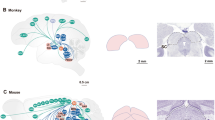Abstract
Pattern visual evoked potentials (VEPs) were recorded from the pial surface of the cat primary visual cortex prior to and following the intravenous administration of physostigmine, an agent which blocks the enzyme responsible for the breakdown of synaptically released acetylcholine. The control VEP was composed of a small initial positive deflection (P1), a subsequent large negative wave (N1) and a second large positive wave (P2). Following physostigmine, the amplitude of P1-N1 was diminished whereas that of N1-P2 increased. These effects were long lasting and were blocked by prior treatment with scopolamine, a result consistent with mediation by a muscarinic cholinergic pathway. Waveform subtraction revealed that the physostigmine-sensitive component had a slow, negative polarity waveform while the physostigmine-insensitive component was also slow, but positive in polarity. The fundamental nature of these components remains to be assessed. Nevertheless, the results indicate that waveforms of different polarity combine algebraically to yield the conventional VEP.
Similar content being viewed by others
References
Arakawa K, Peachey NS, Celesia GG (1993) Spatial frequency response functions obtained from cat visual evoked potentials. Electroencephalogr Clin Neurophysiol 88:143–150
Baro JA, Lehmkuhle S (1989) The effects of a luminance-modulated background on the grating-evoked cortical potential in the cat. Vis Neurosci 3:563–572
Bishop PO, Kozak W, Vakkur GJ (1962) Some quantitative aspects of the cat's eye: axis and plane of reference, visual field co-ordinates and optics. J Physiol (Lond) 163:466–502
Brigell M, Celesia GG (1992) Electrophysiological evaluation of the neuro-ophthalmology patient: an algorithm for clinical use. Sem Ophthalmol 7:65–78
Creutzfeldt OD, Kuhnt U (1973) Electrophysiology and topographical distribution of VEPs in animals. In: Jung R (ed) Handbook of sensory physiology, vol 7, pt 3. Springer, Berlin Heidelberg New York
Crouch JE (1969) Text-atlas of cat anatomy. Lea and Febiger, Philadelphia
DeBruyn EJ, Gajewski YA, Bonds AB (1986) Anticholinesterase agents affect contrast gain of the cat cortical visual evoked potential. Neurosci Lett 71:311–316
Fernald R, Chase R (1971) An improved method for plotting retinal landmarks and focusing the eye. Vision Res 11:95–96
Fitzpatrick D, Raczkowski D (1991) The localization of neurotransmitters in the geniculostriate pathway. In: Dreher B, Robinson SR (eds) Neuroanatomy of the visual pathways and their development, CRC Press, Boca Raton, pp 278–301
Granit R (1947) Sensory mechanisms of the retina. Hafner, New York
Harding TH, Wiley RW, Kirby AW (1983) A cholinergic-sensitive channel in the cat visual system tuned to low spatial frequencies. Science 221:1076–1078
Harding TH, Kirby AW, Wiley RW (1985) The effects of diisopropylfluorophosphate on spatial frequency responsivity in the cat visual system. Brain Res 325:357–361
Hood DC, Birch DG (1992) A computational model of the amplitude and implicit time of the b-wave of the human ERG. Vis Neurosci 8:107–126
Hudnell HK, Boyes WK, Otto DA (1990) Stationary pattern adaptation and the early components in human visual evoked potentials. Electroencephalogr Clin Neurophysiol 77:190–198
Hutchins JB (1987) Review: acetylcholine as a neurotransmitter in the vertebrate retina. Exp Eye Res 45:1–38
Jeffreys DA, Axford JG (1972a) Source locations of pattern-specific components of human visual evoked potentials. I. Component of striate cortical origin. Exp Brain Res 16:1–21
Jeffreys DA, Axford JG (1972b) Source locations of pattern-specific components of human visual evoked potentials. II. Component of extrastriate cortical origin. Exp Brain Res 16:22–40
Kraut MA, Arezzo JC, Vaughan HG Jr (1985) Intracortical generators of the flash VEP in monkeys. Electroencephalogr Clin Neurophysiol 62:300–312
Lesevre N, Joseph JP (1979) Modifications of the pattern-evoked potential (PEP) in relation to the stimulated part of the visual field (clues for the most probable origin of each component). Electroencephalogr Clin Neurophysiol 47:183–203
Maier J, Dagnelie G, Spekreijse J, van Dijk BW (1987) Principal components analysis for source localization of VEPs in man. Vision Res 27:165–177
Millidot M, Riggs LA (1970) Refraction determined electrophysiologically. Responses to alternation of visual contours. Archives Ophthalmol 84:272–278
Ossenblok P, Spekreijse H (1991) The extrastriate generators of the EP to checkerboard onset. A source localization approach. Electroencephalogr Clin Neurophysiol 80:181–193
Pasik P, Molinar-Rode R, Pasik T (1990) Chemically specified systems in the dorsal lateral geniculate nucleus of mammals. In: Cohen B, Bodis-Wollner I (eds) Vision and the brain; the organization of the central visual system. (Association for Research in Nervous and Mental Disease, Research Publications, vol 67). Raven, New York, pp 43–83
Regan D (1989) Human brain electrophysiology: evoked potentials and evoked magnetic fields in science and medicine. Elsevier, New York
Schroeder CE, Tenke CE, Givre SJ, Arezzo JC, Vaughan HG Jr (1991) Striate cortical contribution to the surface-recorded pattern-reversal VEP in the alert monkey. Vision Res 31:1143–1157
Sereno MI, Allman JM (1991) Cortical visual areas in mammals. In: Leventhal AG (ed) The neuronal basis of visual function, vol 4. CRC Press, Boca Raton, pp 160–172
Zemon V, Kaplan E, Ratliff F (1980) Bicuculline enhances a negative component and diminishes a positive component of the visual evoked cortical potential in the cat. Proc Natl Acad Sci USA 77:7476–7478
Author information
Authors and Affiliations
Rights and permissions
About this article
Cite this article
Arakawa, K., Peachey, N.S., Celesia, G.G. et al. Component-specific effects of physostigmine on the cat visual evoked potential. Exp Brain Res 95, 271–276 (1993). https://doi.org/10.1007/BF00229785
Received:
Accepted:
Issue Date:
DOI: https://doi.org/10.1007/BF00229785




